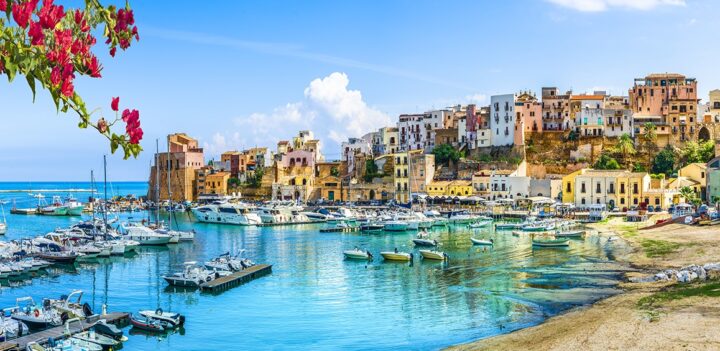
Sicily: Places to visit & tips
Our first stop in Sicily: Palermo. Arriving from Germany by plane worked without any problems, but the traffic in the largest city on Italy’s largest island is the exact opposite.
When people talk about driving in Palermo, vacationers like to use distinctive words like “that’s pure anarchy” – and rightly so! The rush hour lasts from half past seven in the morning to half past eight in the evening. Then six cars drive side by side in three lanes at the same time, with at least three to five Vespas in between, trying to overtake on the right or left or left and right.
But Palermo also has a lot to offer: striking architecture, lively life on squares and in the streets, good restaurants, and you can lose track of time while shopping. Here are some impressions from the city:
As soon as we left the city limits a few days later, we and our brand new, completely unscathed rental car are no longer in danger. Outside of the big cities, driving a car in Sicily is unproblematic, even relaxing on the well-developed country roads. It’s nice that we can take our time on this round trip on our own, by rental car and without a tight schedule.
The weather is right, mostly even in the low season. Africa is not far: from Marsala, for example, it is only 200 kilometers across the sea to ancient Carthage on the African mainland. From April to November, swimming is popular on the island – along the more than 1000 km long coast you will find clear water and bays with light sandy beaches.
The best thing about traveling around Sicily this way is that it is easy to get in touch with the people. It’s a bit difficult with English, but it’s quite good with a few words of Italian. On the small country roads in the interior of the island we experience everyday Sicilian life. Buy fruit from a farmer, watch the olive harvest, let us explain how the good olive oil is made, sit in the harbor pub for an espresso.
And the Sicilian cuisine has it all, it is always sumptuous, everything is prepared with love. The wines are also the finest, be it the full-bodied red from Mount Etna or the Marsala, a highly aromatic liqueur wine. And when it comes to dessert, the Arabic heritage is noticeable, with all sorts of spices, lots of almonds, pistachios and lots of calories.
Such a tour on the largest island in the Mediterranean is always a journey through time: we move from today to the Middle Ages at high speed, and from there to antiquity. Sicily has always been popular with the powerful of the world because of its strategic location. Greeks, Carthaginians, Romans, Ostrogoths, Byzantines, Arabs, Normans, Staufer came, saw, conquered and lost. They all left more or less clear traces. And so it is that today there are more well-preserved Greek temples in Sicily than in Greece itself. At least that’s what the Sicilians say. We didn’t count, but there’s a lot to see.
The stories are the same, whether in Segesta, Agrigento or Selinunte: In the Greek colonies, the inhabitants quickly became rich through agriculture, trade and military raids. And because it was supposed to stay that way, they paid homage to the gods. Here, about 2500 years ago, people erected temples of enormous dimensions, which already showed power and wealth from the sea. At almost all excavation sites, the temples have several names because they were first Greek, then Roman and later perhaps even Christian places of worship. A pleasure to lie between these sacred stones in the shade under a tree, to smell the sea air and thyme, and to browse through the old sagas.
One of the places with a great history is Taormina, today one of the strongholds of tourism, which attracts tens of thousands of holidaymakers every year. Beaches, a beautiful old town, the Corso Umberto, the promenade in the upper town – that is what makes this city so attractive. Everything has its place next to each other. There are the old women in black praying engrossed in the church of San Nico-lò. There are vacationers strolling hand in hand through the streets.
Last day of our Sicily tour. We’re sitting on the steps of the Greco-Roman theater in Taormina, which once seated 30,000 spectators. The sun is biting on the skin, we have 20 degrees at sunset, which is really spectacular from here: the fireball sinks glowing red behind Mount Etna, blowing white clouds into the sky. Mount Doom of the Sicilians is both backdrop and spectacle in the theater of Taormina.
Categories: General
